Vacation Guide
Ireland golf vacation guide :
City and regional guide - Connemara
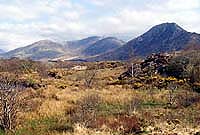 Connemara is a savage beauty", said renowned Irish writer, Oscar Wilde and he really couldn’t have put it better. Connemara is the name given to the wild and beautiful region northwest of Galway City and offers a stunning panorama of lonely valleys, bogs, mountains and lakes. And how do you know if you’re actually in Connemara, you may ask. Well, from the rugged Twelve Bens mountain range in the north through the lake-rich Roundstone Bog, to the golden beaches reaching out into the Atlantic Ocean, you’ll know you’re in Connemara by the light that constantly changes the mood and tone of the landscape. This natural terrain and unspoiled environment offers the visitor a wonderful array of sights and experiences.
Connemara is a savage beauty", said renowned Irish writer, Oscar Wilde and he really couldn’t have put it better. Connemara is the name given to the wild and beautiful region northwest of Galway City and offers a stunning panorama of lonely valleys, bogs, mountains and lakes. And how do you know if you’re actually in Connemara, you may ask. Well, from the rugged Twelve Bens mountain range in the north through the lake-rich Roundstone Bog, to the golden beaches reaching out into the Atlantic Ocean, you’ll know you’re in Connemara by the light that constantly changes the mood and tone of the landscape. This natural terrain and unspoiled environment offers the visitor a wonderful array of sights and experiences.
Connemara can essentially be broken down into regions, each one with its own particular beauties, history and attractions. These regions include Ballyconneely, Ballynahinch & Recess, Carna & Cashel, Cleggan & Claddaghduff, Clifden, Inishbofin & Inishturk, Kylemore & Letterfrack, Leenaun, Renvyle and Roundstone. To give you a good idea of Connemara, it is best to deal with this regions one by one.
Ballyconneely
No visit to Connemara would be complete without a trip to Ballyconneely, home by the way to Connemara Golf Club. Jutting out into the Atlantic Ocean, the peninsula contains some of the most tranquil and natural countryside in Ireland and is virtually ringed by beaches. These superb beaches include Coral Strand, Knock, Dolan, Murvey, Mannin and Ballyconneely Bay. As well as being ideal for bathing, some are also ideal for the shore fisherman.
Ballyconneely has also been to the forefront historically over the years. On Sunday June 14th 1919, the first transatlantic flight, piloted by John Alcock and Arthur Brown, touched down in Derrygimla Bog about two miles from Ballyconneely Village. They landed within yards of the Marconi Wireless Telegraph Station, set up in 1905 by the Italian pioneer of wireless telegraphy, Guiglielmo Marconi and from where the first transatlantic wireless message was sent to Nova Scotia in 1907.
The area is also renowned for its breeding of the world famous Connemara Pony. Legend has it that the breed originated as a result of a number of Arab horses being washed ashore from a Spanish shipwreck and breeding with the native ponies. Today, Ballyconneely is home to a thriving community, while three miles to the east is Roundstone Bog, a vast and tranquil expanse of moor, lake and stream teeming with wildlife and rare plants.
Ballynahinch & Recess
This is an area of bogland, forest and lakes, dominated by the towering quartzite peaks of the Twelve Bens Mountains. Connemara green marble quarries are to be found on the lower slopes of these mountains. The elegant 16th century Ballynahinch Castle, overlooking the Ballynahinch River has been home over the years to the O’Flaherty Chieftains and Grace O’Malley and is indeed an impressive site. The ruins of a 15th century island castle (crannog), built by Donal O’Flaherty, husband of Grace O’Malley or Granuaile, as she was also known, can still be seen here today.
Carna & Cashel
Situated in the heart of the Gaeltacht, Carna is rich in ancient culture and tradition and is an area where Irish is the everyday spoken language. In the 6th century, St. McDara built a small church on one of the islands off the coast of Carna, the unique stone roof of which has recently been restored. Carna is also renowned for its skilled boat-makers, who produce the famous Galway Hookers and Currachs.
The townland of Cashel lies at the head of Cashel Bay and derives its name from the ring fort or cashel, which surrounds the present day graveyard. Cashel Hill stands majestically overlooking the bay, offering the most breathtaking views from its summit and it’s well worth a walk up here.
Cleggan & Claddaghduff
A wild and wonderful stretch of Atlantic coastline characterises the Cleggan and Claddaghduff area of Connemara. The focal point of the picturesque fishing village of Cleggan is its pier, which is the closest mainland link for the beautiful islands of Inishturk and Inishbofin. Traditionally, fishing has supplemented farming as the main source of income in the area, a practice that in 1927 brought devastation to the village of Cleggan. In what became known as the Cleggan Disaster, some 25 fishermen from the local area drowned during a storm that arose while they were mackerel fishing in the bay.
There is much to occupy the visitor to the area, whether on sea or land. A climb to the top of Cleggan Head will reveal the remains of a watchtower, constructed during the Napoleonic Wars and offer stunning vistas of the harbour, Inishbofin, Inishturk, Clare Island, Croagh Patrick and Achill Head.
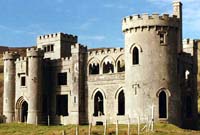 Clifden
Clifden
Set between the Atlantic Ocean and the Twelve Bens Mountains in an area of spectacular scenery on the Connemara coast, lies the town of Clifden. Hill walking, horse riding, beaches, fishing, golfing, national parks, abbeys and castle ruins combine with stunning panoramas to make Clifden an area of great interest in Connemara. Clifden enjoys a reputation as being the gourmet capital of the Connemara and offers a range of fine dining options, while its range of quality shops will satisfy even the most discerning shopper.
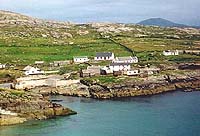 Inishbofin & Inishturk Islands
Inishbofin & Inishturk Islands
Best reached by ferry from Cleggan, Inishbofin, which has a population of around 200, is one of the most beautiful islands off the western coast of Ireland. Due to its inherent tranquility, Inishbofin was chosen by St. Coleman as the site for his monastery in 665 AD and a roofless 13th century chapel, which stands in the present day graveyard is said to mark the site of this monastery. The harbour entrance is dominated by a Cromwellian Fort, which served as a prison camp for Catholic priests, while wildlife abounds both on land and sea.
Inisturk Harbour
Inishturk lies off the Galway coast to the north of Inishbofin and is populated by approximately 100 islanders. With unrivalled scenery, peaceful setting, wholesome cooking and craft making, this is a perfect place to visit. The island is a paradise for outdoor enthusiasts, while the ornithologist will be enthralled by the number of bird sanctuaries. The remains of Celtic and early Christian fortified habitations are still evident and the sheltered beach coves offer the clearest blue waters in Europe.
Kylemore & Letterfrack
Kylemore (Choill Mhór - meaning the big wood) lies at the top of the Inagh Valley and is hidden between the mountains of Connemara and the Atlantic Ocean. The mountainous valley around Kylemore is terraced with forest, while the area is also famous for angling on the three Kylemore loughs. The picturesque Kylemore Abbey, home to a Benedictine order of nuns, stands at the edge of the lake surrounded by woodland. The gothic castle, built in 1865, was bought by the Benedictine order after fleeing their convent in Ypres during World War One. The grounds of the Abbey are open to the public and are well worth visiting.
Kylemore Abbey 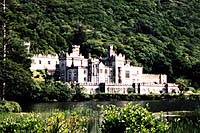 The village of Letterfrack is dominated by Diamond Hill, which is located in the Connemara National Park. The aim of the National Park is landscape conservation and it offers a variety of activities for visitors including walks, talks, audiovisual shows and a display depicting the development of the Connemara landscape over 10,000 years. The old Jesuit school in the village is now owned by the community and includes various craft and exhibition workshops. Ballinakill graveyard contains the ruins of a medieval church as well as a ruined 7th century church and it is here that the remains of Oliver St. John Gogarty are interred.
The village of Letterfrack is dominated by Diamond Hill, which is located in the Connemara National Park. The aim of the National Park is landscape conservation and it offers a variety of activities for visitors including walks, talks, audiovisual shows and a display depicting the development of the Connemara landscape over 10,000 years. The old Jesuit school in the village is now owned by the community and includes various craft and exhibition workshops. Ballinakill graveyard contains the ruins of a medieval church as well as a ruined 7th century church and it is here that the remains of Oliver St. John Gogarty are interred.
Leenane
Often referred to as the gateway to Connemara, the beautiful village of Leenane is situated at the head of Killary Harbour. The harbour extends some ten miles inland and with mountains rising steeply on either side, provides some of the finest scenery in Ireland. With its great variety of sedimentary, volcanic and metamorphic rocks, Leenane is a haven for geologists, while some of the well-known beauty spots include Aasleagh Falls and Doolough Valley, scene of the tragic famine walk. Leenane was also the setting for the film adaptation of John B. Keane’s play "The Field", directed by Jim Sheridan and starring Richard Harris, John Hurt and Tom Berenger. Today, one can visit many of the locations used as sets in the film.
Renvyle
The serene Renvyle peninsula is located at the far western edge of Ireland and is a place in which to enjoy the fresh sea air, peace, beauty and closeness of nature. Amidst this alluring landscape, you will find Derryinver Quay and Ballinakill Harbour, one of the loveliest harbours in the world, from where you can enjoy a scenic coastal cruise. The peninsula has been described by Augustus John as "the most beautiful landscape in the world" and it has inspired some renowned works of art by Yeats, Gogarty and Oscar Wilde. If you have ever watched the film "The Quiet Man", starring John Wayne and wondered about the location of the stunning scenery, now you know – Renvyle is simply wondrous.
Roundstone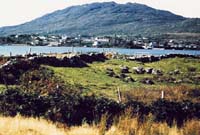 Situated in the heart of Connemara, Roundstone village was built in the 1820’s and is one of the oldest fishing villages on the west coast. Today, its harbour is still busy with local fisherman returning with the day’s catch of lobster, crayfish, crab and mackerel. Roundstone is an area of great natural beauty and has been described as a botanist’s delight, with many rare wild flowers to found in the area known as Errisbeg, which rises to almost 1,000 feet just west of the village.
Situated in the heart of Connemara, Roundstone village was built in the 1820’s and is one of the oldest fishing villages on the west coast. Today, its harbour is still busy with local fisherman returning with the day’s catch of lobster, crayfish, crab and mackerel. Roundstone is an area of great natural beauty and has been described as a botanist’s delight, with many rare wild flowers to found in the area known as Errisbeg, which rises to almost 1,000 feet just west of the village.
Choose another destination
• Aran Islands •Belfast •Connemara •Cork •Dublin •Galway •Kilkenny
•Killarney •Waterford •Wexford •Wicklow



